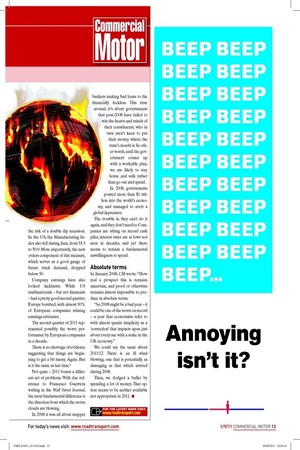Global meltdown
Page 10

Page 11

If you've noticed an error in this article please click here to report it so we can fix it.
Is history about to repeat itself or can world markets be saved from another recession this year?
Words: Ollie Dixon ALMOST THREE years ago, on 15 September 2008, Lehman Brothers iled for bankruptcy and the world changed.
Since then, much of global business has weathered a nuclear winter, with iscal austerity a reality rather than a debating issue.
And now it seems the world’s economy has begun the long walk back to some sort of solvency. In the truck industry at any rate, things had seemed to be on the mend: during the irst six months of 2011, heavy truck (over 16 tonnes) registrations across the EU27+3 rose by more than 30%, with Germany putting on more than 47% growth and previous basket case markets, such as Spain, showing growth of more than 37%.
Gathering storm clouds
Things had been looking quite bright – which is why recent events might have come as a bit of a surprise.
While things had been looking bright(er), some storm clouds were gathering in the background. Rather than carrying raindrops, these clouds were well-stuffed with dark data points, many of which have been making landfall over the past few weeks.
ISM’s Global PMI new orders during June fell from 51 to 49.9 in May, the lowest since May 2009. When this index registers a score below 50, it indicates a decline, which means there might well be the risk of a double dip recession. In the US, the Manufacturing Index also fell during June, from 55.3 to 50.9. More importantly, the new orders component of this measure, which serves as a good gauge of future truck demand, dropped below 50.
Company earnings have also looked lacklustre. While US multinationals – but not inancials – had a pretty good second quarter, Europe bombed, with almost 50% of European companies missing earnings estimates.
The second quarter of 2011 represented possibly the worst performance by European companies in a decade.
There is no shortage of evidence suggesting that things are beginning to get a bit messy. Again. But is it the same as last time?
Not quite – 2011 boasts a different set of problems. With due reference to Francesco Guerrera writing in the Wall Street Journal, the most fundamental difference is the direction from which the storm clouds are blowing.
In 2008 it was all about muppet bankers making bad loans to the inancially feckless. This time around, it’s about governments that post-2008 have failed to win the hearts and minds of their constituents, who in turn aren’t keen to put their money where the state’s mouth is. In other words, until the government comes up with a workable plan, we are likely to stay home and sulk rather than go out and spend. In 2008, governments poured more than $1 trillion into the world’s economy, and managed to avert a global depression.
The trouble is, they can’t do it again, and they don’t need to. Companies are sitting on record cash piles, interest rates are at lows not seen in decades, and yet there seems to remain a fundamental unwillingness to spend.
Absolute terms
In January 2008, CM wrote: “How real a prospect this is remains uncertain, and proof or otherwise remains almost impossible to produce in absolute terms.
“So 2008 might be a bad year – it could be one of the worst on record – a year that economists refer to with almost quaint simplicity as a ‘correction’ that impacts upon just about everyone with a stake in the UK economy.” We could say the same about 2011/12. There is an ill wind blowing, one that is potentially as damaging as that which arrived during 2008.
Then, we dodged a bullet by spending a lot of money. That option seems to be neither available nor appropriate in 2011. ■














































